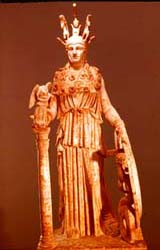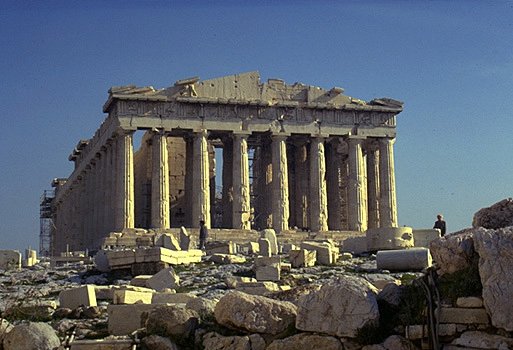The Parthenon - Ancient Temple of Athena Parthenos


The Temple of Athena Parthenos, the Parthenon, is now a ruin lying atop the Acropolis of Athens. The Parthenon was built to house a huge gold and ivory statue of the goddess Athena, patron of the polis of Athens. The polis was the Greeks' distinctive political formation - a walled town with surrounding villages and countryside, and politically independent of its neighbors. The high place of a polis - the acropolis - was the site of shrines to locally important deities.
Work began on the Parthenon in 447 BC and continued until 432 BC. The Parthenon is a Doric peripteral temple. This means that it consists of a rectangular floor plan with a series of low steps on every side, and a colonnade of Doric columns extending around the periphery of the entire structure. Each entrance has an additional six columns in front of it. The larger of the two interior rooms, the naos, housed the statue (a gold and ivory standing figure, forty feet tall, which was clothed in a peplos and wore a helmet decorated with a sphinx and two winged horses. Her lance leaned against her shoulder and the shield was grounded. In her right hand she held the Winged Victory). The smaller room (the opisthodomos) was used as a treasury.

Roman copy, in the National Archeological Museum,
of Phidias's forty foot high statue.
The temple was constructed larger than usual temples so that the statue would not be cramped in the naos. The peristyle consists of eight columns on the short sides and seventeen on the long sides. The building, of Pentelic marble, measures 228 feet by 101 feet. In addition to the decoration of the frieze, the metopes repeated the theme of Victory by depicting the victory of the Athenians over the Amazons, the victory of the gods over the giants, the war between the Centaurs and the Lapiths, and the end of the Trojan War.
Within the Parthenon was a shelter for the Goddess Athena. The Parthenon was not a place open to the masses. The Parthenonís spiritual quality is heightened by the lack of a single, straight, vertical line in the peristyle (the surrounding colonnade). The columns are arranged in diminishing thickness toward the centre of the colonnade. There is diminishing space between the columns, and they lean toward the centre too. All these differences are virtually invisible to the naked eye.

This is a fragment from the frieze surrounding the sacred cella of The Parthenon. The entire frieze (originally comprised of 115 plaques 524 feet in length, 360 figures), pictured the lengthy procession which proceeded from the city gates to The Acropolis to honor the patron goddess of the city. Athena is shown here wearing the helmet with which she is identified.
The Goddess Athena was the armed protector of all Greek poleis, not only Athens. She was the daughter of Zeus and Metis. Zeus heard a prophecy that the child Metis bore after she gave birth to Athena would become the lord of heaven, so, to prevent this from happening, he swallowed Metis while she was still pregnant with Athena. When the time came for Athena to be born, the smith god, Hephaistos, opened Zeus' head with an axe, and Athena stepped out, in full armor.
In the Greek epic Iliad, Athena's warlike qualities are apparent as she sternly thwarts Aphrodite, goddess of erotic desire, and Aphrodite's pawns, the ill-fated lovers Paris and Helen of Troy. Athena's devious cunning inspired Odysseus, hero of the epic Odyssey, to build the Trojan Horse. She also invented the horse-bit, which, for the first time, tamed horses, allowing men to use them. She is, above all, the Goddess of the City, the protectress of civilized life, of artesian activities, and of agriculture. In poetry she is the incarnation of Wisdom, Reason and Purity. Athens is her city; the olive tree, created by her, is her tree; the owl, is the birth consecrated to her.

Take the Quiz to earn points!
1. Who was Athena's father?
2. What's the name of the tree Athena created?
3. How tall was the statue created in honor of Athena and housed in the Parthenon?
4. What year did work on the Parthenon begin? What year did it end?

Pick up your badge after mew take the exam.
To view more pictures of the Parthenon and The Acropolis: